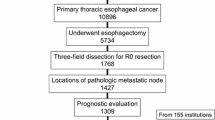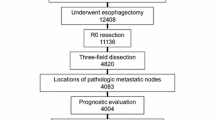Abstract
Background
The optimal extent of lymph-node (LN) dissection in esophageal cancer has not been established. Although the frequency and patterns of recurrence in each regional LN station after radical dissection are important in determining the regional LNs of thoracic esophageal cancer to be routinely dissected, this information has not been investigated sufficiently. We studied the significance of dissection at each LN station based on their recurrence patterns.
Methods
Six hundred and twelve patients with esophageal cancer who underwent curative esophagectomy were studied. The incidence and pattern of recurrence (systemic or non-systemic) at each regional LN station were analyzed. To compare the significance of dissection among regional LNs, the efficacy index (EI) was also calculated.
Results
Regional LN recurrence was diagnosed in 101 (16.5%) patients. Among the regional LNs, recurrent laryngeal nerve, paraesophageal, and perigastric LNs showed higher EIs (3.1–6.7). Pretracheal and posterior thoracic para-aortic LNs showed low EIs (0–0.2). Supraclavicular LNs had moderate EIs (1.7–2.0). The recurrence rate was highest in the pretracheal LN, followed by the supraclavicular LNs. The majority (81.8%) of the pretracheal LN had a systemic recurrence, while about half (right: 60.0%, left: 43.8%) of the supraclavicular LNs had a systemic recurrence.
Conclusion
Due to the high incidence of systemic recurrence or low EI for pretracheal and posterior thoracic para-aortic LNs, we suggest that these LN stations be regarded as non-regional LNs and be excluded from routine dissection. Supraclavicular LNs may also be excluded from routinely dissected stations.


Similar content being viewed by others
References
Peyre CG, Hagen JA, DeMeester SR, et al. The number of lymph nodes removed predicts survival in esophageal cancer: an international study on the impact of extent of surgical resection. Ann Surg. 2008;248:549–56.
Visser E, Markar SR, Ruurda JP, et al. Prognostic value of lymph node yield on overall survival in esophageal cancer patients: a systematic review and meta-analysis. Ann Surg. 2019;269:261–8.
Rice TW, Patil DT, Blackstone EH. 8th edition AJCC/UICC staging of cancers of the esophagus and esophagogastric junction: application to clinical practice. Annals of Cardiothoracic Surg. 2017;6:119–30.
Japan ES. Japanese classification of esophageal cancer, 11th Edition: part I. Esophagus. 2017;14:1–36.
Hagens ERC, van Berge Henegouwen MI, van Sandick JW, et al. Distribution of lymph node metastases in esophageal carcinoma [TIGER study]: study protocol of a multinational observational study. BMC Cancer. 2019;19:662.
Tachimori Y, Ozawa S, Numasaki H, et al. Efficacy of lymph node dissection by node zones according to tumor location for esophageal squamous cell carcinoma. Esophagus. 2016;13:1–7.
Udagawa H, Ueno M, Shinohara H, et al. The importance of grouping of lymph node stations and rationale of three-field lymphoadenectomy for thoracic esophageal cancer. J Surg Oncol. 2012;106:742–7.
Miyata H, Sugimura K, Yamasaki M, et al. Clinical impact of the location of lymph node metastases after neoadjuvant chemotherapy for middle and lower thoracic esophageal cancer. Ann Surg Oncol. 2019;26:200–8.
Depypere L, Lerut T, Moons J, et al. Isolated local recurrence or solitary solid organ metastasis after esophagectomy for cancer is not the end of the road. Dis Esophagus. 2017;30:1–8.
Kosuga T, Shiozaki A, Fujiwara H, et al. Treatment outcome and prognosis of patients with lymph node recurrence of thoracic esophageal squamous cell carcinoma after curative resection. World J Surg. 2011;35:798–804.
Makino T, Yamasaki M, Miyata H, et al. Solitary lymph node recurrence of esophageal squamous cell carcinoma: surgical failure or systemic disease? Ann Surg Oncol. 2016;23:2087–93.
Yano M, Takachi K, Doki Y, et al. Prognosis of patients who develop cervical lymph node recurrence following curative resection for thoracic esophageal cancer. Dis Esophagus. 2006;19:73–7.
Miyata H, Tanaka K, Makino T, et al. The Impact of pathological tumor regression and nodal status on survival and systemic disease in patients undergoing neoadjuvant chemotherapy for esophageal squamous cell carcinoma. Ann Surg Oncol. 2018;25:2409–17.
Parry K, Visser E, van Rossum PS, et al. Prognosis and treatment after diagnosis of recurrent esophageal carcinoma following esophagectomy with curative intent. Ann Surg Oncol. 2015;22(Suppl 3):S1292–300.
Yamamoto M, Yamasaki M, Tanaka K, et al. New classification for the thoracic paraaortic lymph nodes of patients with esophageal squamous cell carcinoma. Surg Today. 2018;48:217–22.
Hatooka S, Abe T, Saito T, et al. Lymph node metastasis of an esophageal cancer behind the thoracic descending aorta. Esophagus. 2010;7:111–4.
Saito H, Sato T, Miyazaki M. Extramural lymphatic drainage from the thoracic esophagus based on minute cadaveric dissections: fundamentals for the sentinel node navigation surgery for the thoracic esophageal cancers. Surg Radiol Anat. 2007;29:531–42.
Wang Y, Zhu L, Xia W, et al. Anatomy of lymphatic drainage of the esophagus and lymph node metastasis of thoracic esophageal cancer. Cancer Manag Res. 2018;10:6295–303.
Shishido Y, Miyata H, Sugimura K, et al. Successful resection after neoadjuvant chemotherapy for esophageal cancer with posterior thoracic paraaortic lymph node metastasis: a case report and literature review. Gen Thorac Cardiovasc Surg. 2017;65:542–8.
Hsu CP, Hsu NY, Shai SE, et al. Pre-tracheal lymph node metastasis in squamous cell carcinoma of the thoracic esophagus. Eur J Surg Oncol. 2005;31:749–54.
Igaki H, Tachimori Y, Kato H. Improved survival for patients with upper and/or middle mediastinal lymph node metastasis of squamous cell carcinoma of the lower thoracic esophagus treated with 3-field dissection. Ann Surg. 2004;239:483–90.
Shimada H, Okazumi S, Matsubara H, et al. Impact of the number and extent of positive lymph nodes in 200 patients with thoracic esophageal squamous cell carcinoma after three-field lymph node dissection. World J Surg. 2006;30:1441–9.
Tachimori Y, Ozawa S, Numasaki H, et al. Supraclavicular node metastasis from thoracic esophageal carcinoma: a surgical series from a Japanese multi-institutional nationwide registry of esophageal cancer. J Thorac Cardiovasc Surg. 2014;148:1224–9.
Koterazawa Y, Oshikiri T, Takiguchi G, et al. Prophylactic cervical lymph node dissection in thoracoscopic esophagectomy for esophageal cancer increases postoperative complications and does not improve survival. Ann Surg Oncol. 2019;26:2899–904.
Mine S, Watanabe M, Kumagai K, et al. Oesophagectomy with or without supraclavicular lymphadenectomy after neoadjuvant treatment for squamous cell carcinoma of the oesophagus. Br J Surg. 2018;105:1793–8.
Shim YM, Kim HK, Kim K. Comparison of survival and recurrence pattern between two-field and three-field lymph node dissections for upper thoracic esophageal squamous cell carcinoma. J Thorac Oncol. 2010;5:707–12.
Cui T, Zhang H, Yu T, et al. Pattern of recurrence in 428 patients with thoracic esophageal squamous cell carcinoma after radical surgery and its implication in postoperative radiotherapeutic clinical target volume. Front Oncol. 2021;11:652365.
Liu Q, Cai XW, Wu B, et al. Patterns of failure after radical surgery among patients with thoracic esophageal squamous cell carcinoma: implications for the clinical target volume design of postoperative radiotherapy. PLoS ONE. 2014;9:e97225.
Wu SG, Dai MM, He ZY, et al. Patterns of regional lymph node recurrence after radical surgery for thoracic esophageal squamous cell carcinoma. Ann Thorac Surg. 2016;101:551–7.
Ni W, Yang J, Deng W, et al. Patterns of recurrence after surgery and efficacy of salvage therapy after recurrence in patients with thoracic esophageal squamous cell carcinoma. BMC Cancer. 2020;20:144.
Author information
Authors and Affiliations
Corresponding author
Ethics declarations
Ethical statement
All procedures followed were in accordance with the ethical standards of all participating hospitals and with the Helsinki Declaration of 1964 and later versions.
Conflict of interest
There are no conflicts of interest to disclose.
Additional information
Publisher's Note
Springer Nature remains neutral with regard to jurisdictional claims in published maps and institutional affiliations.
Supplementary Information
Below is the link to the electronic supplementary material.
Rights and permissions
Springer Nature or its licensor (e.g. a society or other partner) holds exclusive rights to this article under a publishing agreement with the author(s) or other rightsholder(s); author self-archiving of the accepted manuscript version of this article is solely governed by the terms of such publishing agreement and applicable law.
About this article
Cite this article
Kanemura, T., Miyata, H., Takeoka, T. et al. Significance of dissection in each regional lymph-node station of esophageal cancer based on efficacy index and recurrence patterns after curative esophagectomy. Esophagus 20, 402–409 (2023). https://doi.org/10.1007/s10388-022-00977-8
Received:
Accepted:
Published:
Issue Date:
DOI: https://doi.org/10.1007/s10388-022-00977-8




